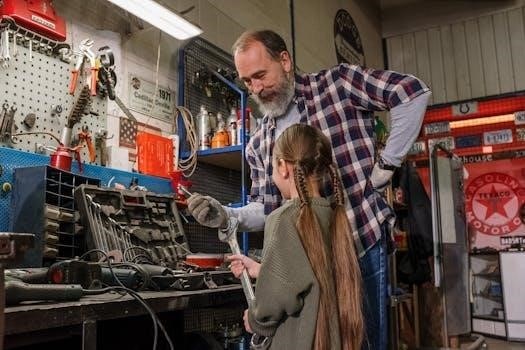The Little Giant incubator is designed for poultry enthusiasts, offering a controlled environment for hatching eggs․ It utilizes a simple principle⁚ raising normal room temperature to an optimal hatching heat․ These incubators are not intended for professional or commercial use․
Understanding the Purpose of an Incubator
An incubator’s primary function is to replicate the natural conditions a hen provides for eggs during incubation․ This involves maintaining a consistent temperature, typically higher than room temperature, to facilitate embryonic development within the egg․ The Little Giant incubator achieves this by bringing normal room temperature up to the desired hatching temperature․ It is crucial for successful hatching, as fluctuations in temperature can negatively impact the development of chicks․ The incubator provides a controlled space, protecting the eggs from drafts and temperature variations that are common in a normal room environment․ Furthermore, some models may also control humidity levels, which is another essential factor for successful incubation․ This controlled environment allows for the consistent development of eggs, increasing the chances of successful hatching compared to natural methods․ By using an incubator, poultry enthusiasts can hatch eggs even when a broody hen isn’t available, and also hatch a larger batch at once․ It’s essential to set the incubator in a stable area, away from direct sunlight or drafts, to ensure it provides consistent results․

Little Giant Incubator Models
Little Giant offers several incubator models, including the 9200, 9300, and 10300․ The 9200 and 9300 are still air incubators, while the 10300 utilizes circulated air for more even temperature distribution within the incubator․
Still Air Incubator 9200 Features
The Little Giant 9200 Still Air Incubator is designed to provide a simple yet effective environment for hatching eggs․ This model is well-suited for beginners and hobbyists and has a capacity to hold 118 quail eggs, 40 duck or turkey eggs, 90 pheasant eggs, or 46 chicken eggs․ The 9200 operates by raising normal room temperature to an appropriate hatching heat․ It relies on still air to maintain the temperature, meaning there is no fan for air circulation․ This incubator is ideal for a stable room temperature․ The 9200 model has built-in moisture rings to maintain the needed humidity levels, which is important during incubation․ It is important to place the incubator in a room with a stable temperature, avoid drafty areas, and direct sunlight․ The ideal room temperature should be about 70ºF․ This model is user-friendly, making it a great choice for hatching various poultry eggs at home․ The eggs will hatch in 17 to 28 days, depending on the specific species․
Still Air Incubator 9300 Overview
The Little Giant 9300 Still Air Incubator offers another option for those seeking a simple method for hatching eggs․ Like the 9200 model, the 9300 operates on the principle of raising ambient room temperature to reach the necessary heat for incubation․ This particular model can operate effectively in a room with a stable temperature․ The 9300 is also suitable for general poultry hobbyists but is not recommended for professional use, commercial use, or for incubating exotic birds or reptiles․ Similar to the 9200, the 9300 also utilizes still air, which means there is no fan․ Therefore, it’s important that the incubator be placed in an environment that can maintain a stable temperature․ Little Giant accessories are important to use in order to maintain the warranty․ The 9300 is designed for hatching various poultry types and can hold 41 large chicken eggs or up to 120 bantam or quail eggs when used with the Little Giant automatic egg turner․ It is important to remember that this incubator is designed for hobbyists․
Circulated Air Incubator 10300 Details
The Little Giant 10300 Circulated Air Incubator is a more advanced option, differing from the still air models․ The 10300 utilizes a fan to circulate air within the incubator․ This helps maintain a more consistent temperature throughout the interior․ This model, like others, is designed for hobbyists and is not recommended for professional or commercial use or for incubating exotic birds or reptiles; The 10300 is designed to hold 41 large chicken eggs or up to 120 bantam or quail eggs when used with the Little Giant automatic egg turner․ This incubator includes built-in moisture rings in the base․ The circulated air design helps to ensure even heat distribution, which can be beneficial for successful hatching․ It’s important to use Little Giant accessories to maintain the warranty; The 10300, similar to the other models, operates by raising the ambient room temperature to the necessary level for hatching․ The model is suited for hatching different types of poultry eggs․ The automatic egg turner is included with this model․

Setting Up Your Little Giant Incubator
Proper setup is crucial for successful hatching․ Choose a location with stable temperature, avoiding drafts and direct sunlight․ The ideal room temperature is around 70°F․ These factors will impact the incubator’s performance․
Choosing the Ideal Location for Your Incubator
Selecting the right location for your Little Giant incubator is paramount for successful egg incubation․ A stable environment is crucial to maintaining the consistent temperature required for proper embryonic development․ Avoid drafty areas such as near windows, doors, or in garages, as temperature fluctuations can negatively affect the hatching process․ Similarly, refrain from placing the incubator in direct sunlight, which can cause overheating and inconsistent temperature readings․ The ideal room temperature for optimal incubator performance is around 70ºF (21ºC)․ A room with minimal temperature variations will ensure the incubator requires very few adjustments after the initial setup․ Ensure the surface where the incubator is placed is level and stable to prevent any accidental tipping or movement․ It’s best to choose a location that is easily accessible for monitoring and maintenance, yet away from heavy foot traffic or potential disturbances․ Proper placement is a simple but essential step to ensuring a successful hatch rate for your eggs․

Operating Your Little Giant Incubator
Operating your Little Giant incubator involves regulating temperature and humidity, along with proper egg turning and placement․ Consistent monitoring is key to a successful hatch․ It is important to follow instructions carefully․
Regulating Temperature and Humidity
Maintaining the correct temperature and humidity levels is crucial for successful egg incubation in your Little Giant incubator․ The incubator functions by elevating the room’s temperature to the required hatching temperature․ A stable room temperature, ideally around 70º F, is essential for optimal performance; avoid drafty locations, direct sunlight, or areas with temperature fluctuations․ Once the incubator is set, minimal adjustments should be needed if room conditions are consistent․ To regulate temperature, turn the thermostat control knob clockwise until the red light turns on․ For humidity, add water to the built-in moisture rings in the base of the incubator, carefully following guidelines specific to the species of eggs you are incubating․ Monitoring these parameters closely is vital, as both temperature and humidity play significant roles in the development of the embryos․ Use a reliable thermometer and hygrometer to keep track of conditions inside the incubator, making minor adjustments as needed to achieve optimal conditions for your specific eggs․ Remember that the specific temperature and humidity requirements can vary, so consult reliable sources for the species of eggs you are incubating․
Egg Turning and Placement
Proper egg turning and placement are vital for successful hatching within a Little Giant incubator․ Manual turning is necessary in still-air models unless an automatic turner is used․ Eggs should be turned at least three times daily, preferably more, to prevent the embryo from sticking to the shell․ When placing eggs, ensure they are positioned correctly, typically with the pointed end down․ The incubator can hold varying amounts of eggs, depending on species and size; for instance, the 9200 model can accommodate 118 quail eggs, 40 duck or turkey eggs, 90 pheasant eggs, or 46 chicken eggs․ Utilizing an automatic egg turner, if available, can significantly reduce the need for manual turning․ Always handle eggs with clean hands and avoid placing them directly on the incubator floor; using the provided plastic mesh screen is recommended․ Consistency in turning and placement is key to providing each egg the proper environment for development․ Moreover, be sure not to overcrowd the incubator, as proper spacing is necessary to allow for even air circulation․

Maintenance and Troubleshooting
Maintaining your Little Giant incubator involves regular cleaning and checking for any malfunctions․ Using only Little Giant accessories helps uphold the warranty․ Common issues include temperature fluctuations or humidity imbalances, which need prompt attention for successful hatching․
Warranty Information and Accessory Use
Little Giant products, including their incubators, come with a warranty that protects the original purchaser against defects in material and workmanship under normal use․ To ensure the warranty remains valid, it is crucial to use only Little Giant-branded accessories․ Using third-party accessories could void the warranty, as they may not meet the specific requirements of the incubator’s design and operation․ This includes items like automatic egg turners, humidity control devices, and replacement parts․ The warranty typically covers the incubator itself and its basic components but may not extend to damage caused by misuse, negligence, or unauthorized modifications․ Detailed warranty information can usually be found in the product’s instruction manual or on the manufacturer’s website․ It is advisable to carefully review the warranty terms to understand the specific coverage and limitations․ Proper care and maintenance, along with the use of compatible accessories, are essential for a long-lasting and reliable incubator experience․ Always consult the official documentation for precise details․
Common Issues and Solutions
One common issue with Little Giant incubators is inconsistent temperature, often caused by drafts or fluctuations in room temperature․ Ensuring the incubator is placed in a stable environment away from windows and direct sunlight is crucial․ Another frequent problem is incorrect humidity levels․ This can be addressed by using the built-in moisture rings properly․ If the incubator isn’t heating, check the thermostat control knob and ensure the red indicator light is on․ Egg turning mechanisms can sometimes malfunction; ensuring the automatic turner is correctly installed and functioning is key․ If eggs fail to hatch, review the incubation period for your specific poultry type․ Also, consider external factors like egg handling and storage before incubation․ Consult the manual to see if your model is functioning correctly․ If you encounter persistent issues, consult the manufacturer’s website or support channels for additional troubleshooting advice․ Remember, proper setup and adherence to the instruction manual are essential for successful hatching․
